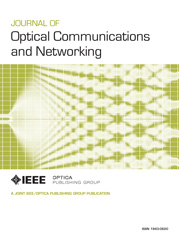JOCN Special Issue on Low-Margin Optical Networks
Submissions Open: 1 February 2019
Submission Deadline: 25 March 2019
When optical-bypass-enabled networks were first deployed in the 2000 timeframe, approximate system rules regarding quality of transmission (QoT) and connection margin were utilized to govern network design. These rules were applied uniformly across the usable spectrum such that all wavelengths were assumed to have the same performance, e.g., optical reach. Systems were typically 'closed', with all equipment provided by a single vendor. This was partially necessitated by the difficulty in adequately characterizing system performance in an all-optical environment and establishing industry-wide design rules. Additionally, networks were quasi-static, with most connections remaining in place for years, necessitating the incorporation of an end-of-life (EOL) margin to account for fiber and equipment aging effects.
The current state of optical transport networks is dramatically different, motivated by the advent of flexible (elastic) optical networks, the shift to more dynamic networks, and the desire for 'open' networks. Advanced transmission technology allows the bandwidth and optical reach of each individual wavelength to be programmed. Connections may remain in place for only seconds, such that EOL margins are irrelevant. Multi-vendor networks are finally becoming a reality. While advanced configurable technology was the foundational enabler of this evolution, advancements in QoT estimation are what allow the system designer to take full advantage of it to optimize system performance.
The purpose of this special issue is to investigate low-margin optical networks, where more precise knowledge of QoT allows the deployment of each wavelength to be tailored to the network state and the carried services. We are interested in: techniques to more precisely estimate performance; novel design algorithms that maximize the benefits of this improved intelligence; analyses of the impact on network control and the complexity added to network operation given that a small deterioration in QoT can bring down a connection. In addition, we are interested in how QoT advancements support open systems with respect to multi-vendor networks and alien wavelengths.
More specifically, the scope of the special issue includes but is not limited to the following topics:
- Techniques for estimating QoT in real time (e.g., computational, machine-learning-based, etc.)
- Innovative architectures and applications that can take advantage of low-margin network design
- Network control and management in a low-margin environment (e.g., monitoring, protection, etc.)
- The risks involved with operating a low-margin network, and how to mitigate them
- Techno-economic studies that evaluate benefits vs. added complexity
- Multi-vendor operation and demonstrations enabled by enhanced QoT estimation
- Alien wavelength implementation and control
Submissions to the special issue should be prepared according to the usual standards for the Journal of Optical Communications and Networking and will undergo the normal peer review process. Manuscripts must be uploaded through OSA's online submission system specifying from the Feature Issue drop-down menu that the manuscript is for the issue on Low-Margin Optical Networks.
Special Issue Guest Editors
Yvan Pointurier, Nokia Bell Labs, France (Lead Guest Editor)
Jean-Luc Augé, Orange Research Labs, France
Martin Birk, AT&T, USA
Manos Varvarigos, National Technical University of Athens, Greece

